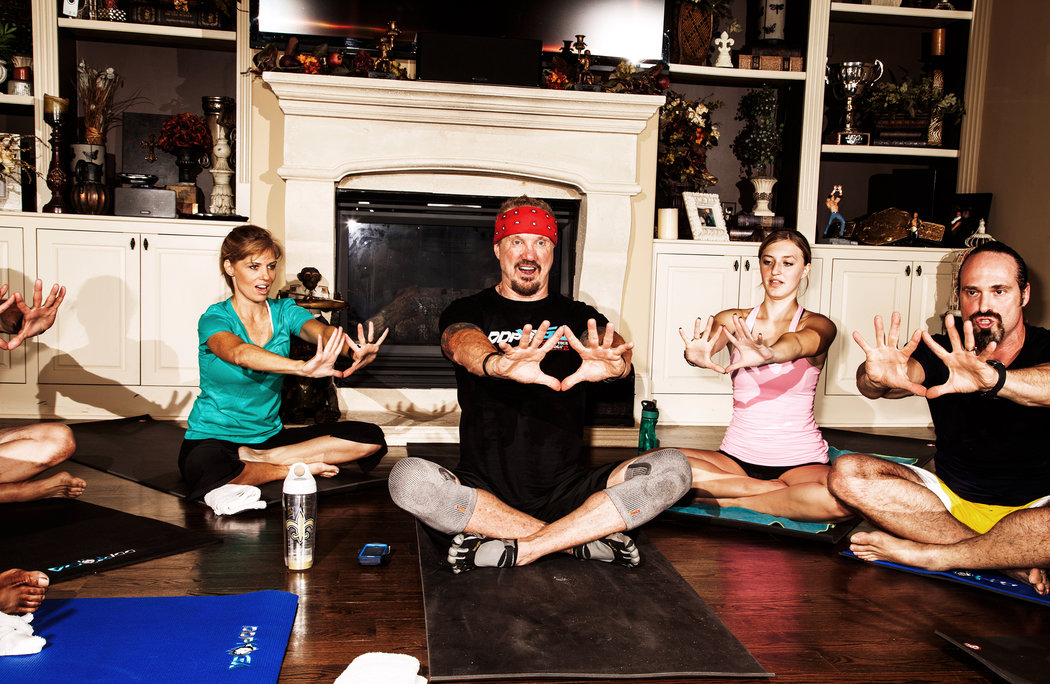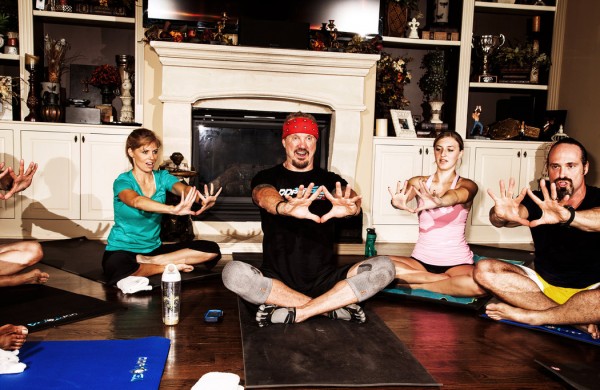
15 Aug The Rise of Beefcake Yoga

Diamond Dallas Page, a former W.W.E. wrestler, leading a yoga session in his home outside Atlanta. Credit Amy Lombard for The New York Times
Here is an inspiring article by Alex French about the debilitating toll that professional wrestling has taken on many of its participants and one man’s crusade to help these people heal with a hybrid of Ashtanga, Yoga.
A horde of screaming middle-aged wrestling fans gathered one Saturday evening in April at the Smoothie King Center in New Orleans to celebrate professional wrestling’s Hall of Fame induction ceremony. The world’s most popular fake-sport organization, World Wrestling Entertainment doesn’t maintain a brick-and-mortar Hall of Fame — no bronze plaques to commemorate its greats (the Ultimate Warrior, Superfly Jimmy Snuka), no interactive widgets to teach young fans storied techniques (“the camel clutch,” “the piledriver”). Instead, once a year, W.W.E.’s former stars relive their glory together, on a stage, face to face with thousands of their most fervent admirers. Throughout the preceding week, these fans traipsed up and down Bourbon Street until 2 a.m., screaming the names of their favorite wrestlers into the night. Now they wore fake championship belts and chanted ecstatically as retired stars strutted by in big ‘n’ tall tuxedos and sequined gowns. A deafening “hoooe!” greeted (Hacksaw) Jim Duggan; (Nature Boy) Ric Flair earned a high-pitched “woooo!” Hulk Hogan, who arrived in a black suit, black bandanna and yellow wraparound shades, sent hundreds of so-called Hulkamaniacs into a fit of rapture.
This year’s gathering was devoted, in part, to the induction of Jake (the Snake) Roberts. During his prime, from the mid-’80s to early ’90s, Roberts, a lithesome 6-foot-5, was often joined in the ring by Damien, his pet Burmese python, which he carried in a canvas sack. His signature move was the ghastly DDT, which required him to grab his opponent into a front face lock and then fall backward, driving the victim’s head into the mat or the arena’s concrete floor. Roberts would then place Damien atop his stunned foe’s chest, his face contorted in a menacing taunt. “You don’t play around with people like me,” he was fond of saying, “because people like me don’t play.”
Roberts was a first-rate entertainer and, despite the scripted nature of his sport, a gifted technical wrestler. But like many of his contemporaries, he had a difficult time walking away from the limelight. After his career petered out in the late ’90s, he performed sporadically at events in Europe until he hung up his snakeskin boots for good in 2011, at 55. But Roberts was miserable in retirement; he missed traveling the circuit with his buddies and performing in front of tens of thousands of fans. His use of pills, alcohol and cocaine, once recreational, turned into feverish addictions. He became depressed. He and his children barely spoke.
All the while, Roberts suffered from debilitating pain. “I couldn’t squat down, I couldn’t get down on my hands and knees,” he told me. “I weighed 308 pounds. My daily workout was a crack pipe and a six-pack.” He holed up in a small home in Gainesville, Tex. The wrestling world kept its distance.
Over the phone, Page suggested that Roberts give yoga a try, too. “I was like ‘O.K., Dallas, O.K.,’ ” Roberts says. “I was trying to get off the phone so I could go pick up my drugs.” But Roberts eventually acquiesced, and within weeks he was attending daily sessions in Page’s Atlanta home. Page monitored his progress every day and posted inspirational clips to YouTube. Within a couple of years, Roberts had sobered up and lost weight; his body, once soft and inflexible, was lean and limber again.


Sorry, the comment form is closed at this time.